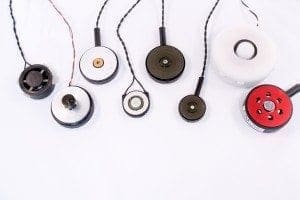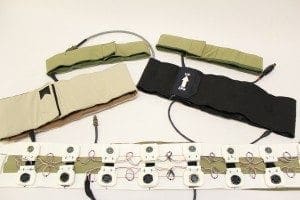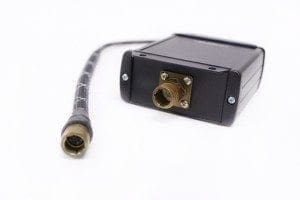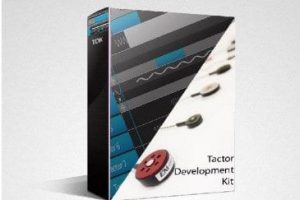
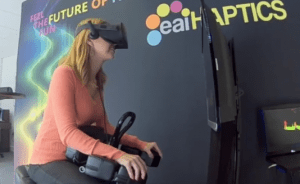
Add the sense of touch to your entertainment platform: Integrate EAI Haptics into your product or platform to add an immersive new dimension to your experience! Learn More.
Tactors
Tactors are small actuators that vibrate against the skin to provide a physical stimulus in response to an electrical input.
Tactile Cueing
Tactile Cueing is the process of using single or multiple vibrational stimuli, applied at appropriate locations around the body, to provide information to a user through the sense of touch.
Advanced Tactile Array Cueing (ATAC™) uses an array of tactors to convey a cue, message or information to the user – a wearable tactile display.
Features common to all ATAC™ tactors:
- Small, light-weight.
- Easy to integrate into clothing.
- Operation doesn’t degrade with loading by the skin or clothing.
- Dynamic and precise signal response.
- Safe and reliable.
ATAC™ systems have been applied to:
- Safety of flight systems for pilots.
- Soldier navigation and communications.
- Biomedical feedback.
- Virtual reality.
- Multiple commercial and research applications.
The sense of touch is integral to our understanding and exploration of the world around us. Touch comprises multiple distinct systems, collectively known as the somatosensory system. Various sensory receptors located are within the skin (dermis and epidermis) as well as in the muscles, tendons and joints. Tactors are wearable actuators that convert electrical energy into vibration displacements that stimulate receptors in the skin.
EAI has developed a range of commercial and custom tactors. We have developed actuator designs based on pneumatic, electromagnetic (linear and rotary drive), dielectric elastomers (artificial muscle), piezoelectric and elastomeric actuators.
EAI baseline ATAC™ products consist of the C-2 tactor and a variety of multi-channel controllers. The C-type tactors utilize a moving magnet and typically operate at higher frequencies (>200 Hz), while the EM-type tactors utilize an eccentric mass motor and operate at lower frequencies (<120 Hz) and at high displacement. In addition, EAI also provides a range of specialist tactors: the C2-HD is a very high force tactor designed for use in a seat, the C2-HDLF is a high displacement actuator designed for low-frequency, the CLF-AN tactor is a high force, low-frequency actuator specifically designed for in-seat use, and the wide-bandwidth PiezoTac tactors are non-magnetic (potentially MRI-compatible), wide-bandwidth and low profile.
ATAC™ systems can be configured as portable, light weight, battery-powered systems or lab based, rack-mount instruments. USB, serial, or Bluetooth interfaces are supported. Wearable tactor arrays are available in various mounting configurations, and in pre-made elasticized belts, bands, and vests. These components have been used in a wide variety of military, commercial, research and biomedical systems.
ATAC™ technology provides researchers and developers with a range of proven tactile transducers (tactors), tactile arrays and the associated hardware and software systems. This enables a multitude of practical tactile systems for military and commercial applications.
The sense of touch is intrinsically linked to motor areas of the brain and is also arranged somotopically. This means that our sense of touch is wired with an intuitive mapping of direction and spatial awareness. Thus, tactile cueing is particularly well suited to providing directional, guidance, and communication cues.
Tactile cueing offers the advantages of omni-presence (they are always available to the user with few competing demands for the tactile channel) and omni-directionality (the user does not need to be looking in a specific place to receive tactile feedback) and they can be applied at almost any place on the body – in effect, acting as “eyes in the back of the head”.
EAI’s ATAC™ systems consist of several technology components that can be combined and configured (by EAI or the user) to implement various applications:
- Wearable and seat mounted vibrotactile transducers and arrays.
- Tactor controllers.
- Wired and wireless interface.
- Application and development software.

